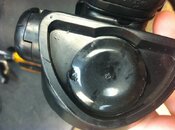halocline
Contributor
Went diving yesterday and my primary second stage still flooded. My new Zenith secondary second stage did not (maybe me memory for the primary dives are a bit fuzzy)
Did the test you described above and was able to draw air in my recently serviced second stage. I'll take it into the shop and have them fix it.
That probably means there's a problem with the 2nd stage. Occasionally there are 2nd stages that have a seat-saver feature that keeps the valve open when it's not pressurized. If your alternate has that feature, the vacuum test won't work because air gets in the alternate, flows up the hose to the first stage, then out to the 2nd stage that you're testing. Usually when I get some air on a vacuum test of a 2nd stage, I'll then take it off the 1st stage, put my thumb over the inlet fitting, and try again. This isolates the 2nd stage completely and you know for a fact that if you get any air, it means a leaky 2nd stage. You could try that if you want to; it's pretty easy to take the 2nd stage off at the first stage, then just cover up the hose end with your thumb. Any leak in the hose would have resulted in a monster stream of bubbles while you diving, so you can eliminate that.




